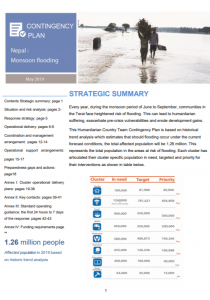
Every year, during the monsoon period of June to September, communities in the Terai face heightened risk of flooding. Such risks can lead to humanitarian suffering, exacerbate pre-crisis vulnerabilities and erode development gains
The aim of this document is to strengthen preparedness planning in seven provinces with a focus on highly flood prone areas in the Terai.
This year, a ‘normal’ monsoon has been predicated for Nepal by the Department of Hydrology and Meteorology. Monsoon rainfall in 2019 in eastern Nepal is estimated to be below normal while western Nepal, it is likely to be normal. These average forecasts do not predict flooding, likely heavy rainfall or landslide possibility. This contingency plan is based on the responses should flooding occur under these conditions, revisions may be necessary as the forecast is updated.
To optimize the speed and volume of critical assistance in the aftermath of a flood the HCT has developed this document to:
- Reach a common understanding of flood risk and how to monitor potential flooding in the Terai to ensure early action is taken;
- Establish a minimum level of flood preparedness across eight core Clusters (Protection, Food Security, Nutrition, Health, Shelter, Water, Sanitation and Hygiene (WASH), Education and Early Recovery). Noting the significance of inter-Cluster support provided by the Logistics Cluster.
- Establish the parameters for a joint HCT response strategy. This aims to meet the needs of people in need of assistance in the first 30 days of a humanitarian emergency in support of the Government of Nepal;
